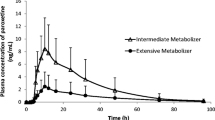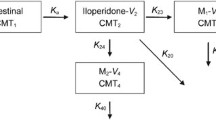Abstract
Background
Approximately 7% of Caucasians have genetically impaired activity of the cytochrome P450 enzyme CYP2D6 and are classified as poor metabolizers (PM). The disposition of thioridazine has been related to the CYP2D6 phenotype. The present study aimed to evaluate the influence of CYP2D6 and CYP2C9 genotypes, and tobacco smoking on steady-state thioridazine plasma levels.
Methods
Seventy-six Caucasian psychiatric patients receiving thioridazine monotherapy were studied. Debrisoquine metabolic ratio (MR) and steady-state plasma levels of thioridazine and its metabolites, mesoridazine and sulforidazine, as well as CYP2D6 (in 74 patients) and CYP2C9 (in 63 patients) genotypes were determined.
Results
The median dose-corrected, steady-state plasma concentrations (C/D) of thioridazine were related to the number of functional CYP2D6 alleles (P<0.01), being 15.2, 7.2, 4.0, 4.2 nmol/l per milligram in subjects with no, one, two, and three or more functional CYP2D6 genes, respectively. No significant differences were found in the C/Ds of mesoridazine or sulforidazine. No relationship was found between CYP2C9 genotype and plasma levels of thioridazine or its metabolites. The median C/D of thioridazine was significantly (P<0.001) lower in smokers (4.0 nmol/l per milligram, range: 1.0–15.5; n=58) than in nonsmokers (7.4 nmol/l per milligram, range: 2.8–23.6; n=18). Also, the C/Ds of mesoridazine and sulforidazine were lower in smokers (P<0.01). The plasma thioridazine/mesoridazine ratio significantly correlated with the debrisoquine MR (r 2=0.30, P<0.001).
Conclusion
The results show that the plasma concentrations of thioridazine and its metabolites are influenced by tobacco smoking and the CYP2D6 genotype, and support the dose-dependent inhibition of CYP2D6 by thioridazine. CYP2C9 does not play an important role in thioridazine metabolism.


Similar content being viewed by others
References
Lin G, Hawes EM, McKay G, Korchinski ED, Midha KK (1993) Metabolism of piperidine-type phenothiazine antipsychotic agents. IV. Thioridazine in dog, man and rat. Xenobiotica 23:1059–1074
Kilts CD, Knight DL, Mailman RB, Widerlov E, Breese GR (1984) Effects of thioridazine and its metabolites on dopaminergic function: drug metabolism as a determinant of the antidopaminergic actions of thioridazine. J Pharmacol Exp Ther 231:334–342
Johansson I, Lundqvist E, Bertilsson L, Dahl ML, Sjöqvist F, Ingelman-Sundberg M (1993) Inherited amplification of an active gene in the cytochrome P450 CYP2D locus as a cause of ultrarapid metabolism of debrisoquine. Proc Natl Acad Sci USA 90:11825–11829
Dahl ML, Johansson I, Bertilsson L, Ingelman-Sundberg M, Sjöqvist F (1995) Ultrarapid hydroxylation of debrisoquine in a Swedish population. Analysis of the molecular genetic basis. J Pharmacol Exp Ther 274:516–520
Agúndez JA, Ledesma MC, Ladero JM, Benítez J (1995) Prevalence of CYP2D6 gene duplication and its repercussion on the oxidative phenotype in a white population. Clin Pharmacol Ther 57:265–269
Bernal ML, Sinues B, Johansson I, McLellan RA, Wennerholm A, Dahl ML, Ingelman-Sundberg M, Bertilsson L (1999) Ten percent of North Spanish individuals carry duplicated or triplicated CYP2D6 genes associated with ultrarapid metabolism of debrisoquine. Pharmacogenetics 9:657–660
LLerena A, Cobaleda J, Martínez C, Benítez J (1996) Interethnic differences in drug metabolism: influence of sex-related and environmental factors on debrisoquine hydroxylation phenotype. Eur J Drug Metab Pharmacokinet 21:129–138
Bahr C von, Movin G, Nordin C, Liden A, Hammarlund-Udenaes M, Hedberg A, Ring H, Sjöqvist F (1991) Plasma levels of thioridazine and metabolites are influenced by the debrisoquine hydroxylation phenotype. Clin Pharmacol Ther 49:234–240
Eap CB, Guenter TW, Schäublin-Loidl M, Stabl M, Koeb L, Powell K, Baumann P (1996) Plasma level of the enantiomers of thioridazine, thioridazine 2-sulfoxide, thioridazine 2-sulfone, and thioridazine 5-sulfoxide in poor and extensive metabolizers of dextrometorphan and mephenytoin. Clin Pharmacol Ther 59:322–331
Bahr C von, Spina E, Birgensson C, Ericsson Ö, Henthorn T, Sjöqvist F (1985) Inhibition of desmethylimipramine 2-hydroxylation by drugs in human liver microsomes. Biochem Pharmacol 34:2501–2505
Benítez J, Piñas B, García MA, Martínez C, LLerena A, Cobaleda J (1989) Debrisoquine oxidation phenotype in psychiatric patients. Psychopharmacol Ser 7:206–210
Spina E, Martinez C, Caputti AP, Cobaleda J, Piñas B, Carrillo JA, Benítez J (1991) Debrisoquine oxidation phenotype during neuroleptic monotherapy. Eur J Clin Pharmacol 41:467–470
Baumann P, Meyer JW, Amey M, Baettig D, Bryois C, Jonzier-Perey M, Koeb L, Monney C, Woggon B (1992) Dextromethorphan and mephenytoin phenotyping of patients treated with thioridazine or amitriptyline. Ther Drug Monit 14:1–8
LLerena A, Berecz R, Rubia A de la, Fernández-Salguero P, Dorado P (2001) Effect of thioridazine dosage on the debrisoquine hydroxylation phenotype in psychiatric patients with different CYP2D6 genotypes. Ther Drug Monit 14:616–620
Yasui N, Otani K, Kaneko S, Ohkubo T, Osanai T, Ishida M, Mihara K, Kondo T, Sugawara K, Fukushima Y (1995) Inhibition of trazodone metabolism by thioridazine in humans. Ther Drug Monit 17:333–335
Maynard GL, Soni P (1996) Thioridazine interferences with imipramine metabolism and measurement. Ther Drug Monit 18:729–731
Stormer E, Brockmoller J, Roots I, Schmider J (2000) Cytochrome P-450 enzymes and FMO3 contribute to the disposition of the antipsychotic drug perazine in vitro. Psychopharmacology (Berl) 151:312–320
Lavin MR, Siris SG, Mason SE (1996) What is the clinical importance of cigarette smoking in schizophrenia? Am J Addict 5:189–208
Goff DC, Henderson DC, Amico E (1992) Cigarette smoking in schizophrenia: relationship to psychopathology and medication side effects. Am J Psychiatry 149:1189–1194
LLerena A, Rubia A de la, Peñas-LLedó E, De Leon J (2002) Schizophrenia and smoking in Spanish psychiatric patients. Schizophr Res 58:323–327
Jann MW, Saklad SR, Ereshefsky L, Richards AL, Harrington CA, Davis CM (1986) Effects of smoking on haloperidol and reduced haloperidol plasma concentrations and reduced haloperidol clearance. Psychopharmacology 90:468–470
Ereshefsky L, Jann MW, Saklad SR, Davis CM, Richards AL, Burch NR (1985) Effects of smoking on fluphenazine clearance in psychiatric inpatients. Biol Psychiatry 20:329–332
Perry PJ, Miller DD, Arndt SV, Smith DA, Holman TL (1993) Haloperidol dosing requirements: the contribution of smoking and nonlinear pharmacokinetics. J Clin Psychopharmacol 13:46–51
Vinarova E, Vinar O, Kalvach Z (1984) Smokers need higher doses of neuroleptic drugs. Biol Psychiatry 19:1265–1268
Benítez J, LLerena A, Cobaleda J (1988) Debrisoquine oxidation polymorphism in a Spanish population. Clin Pharmacol Ther 44:74–77
Marez D, Legrand M, Sabbagh N, Guidice JM, Spire C, Lafitte JJ, Meyer UA, Broly F (1997) Polymorphism of the cytochrome P450 CYP2D6 gene in a European population: characterization of 48 mutations and 53 alleles, their frequencies and evolution. Pharmacogenetics 7:193–202
Gaedigk A, Gotschall RR, Forbes NS, Simon SD, Kearns GL, Leeder JS (1999) Optimization of cytochrome P4502D6 (CYP2D6) phenotype assignment using a genotyping algorithm based on allele frequency data. Pharmacogenetics 9:669–682
Hersberger M, Marti-Jaun J, Rentsch K, Hanseler E (2000) Rapid detection of the CYP2D6*3, CYP2D6*4, and CYP2D6*6 alleles by tetra-primer PCR and of the CYP2D6*5 allele by multiplex long PCR. Clin Chem 8:1072–1077
Lundqvist E, Johansson I, Ingelman-Sundberg M (1999) Genetic mechanisms for duplication and multiduplication of the human CYP2D6 gene and methods for detection of duplicated CYP2D6 genes. Gene 226:327–338
Yasar Ü, Eliasson E, Dahl ML, Johansson I, Ingelman-Sundberg M, Sjöqvist F (1999) Validation of methods for CYP2C9 genotyping: frequencies of mutant alleles in a Swedish population. Biochem Biophys Res Commun 254:628–631. Erratum in: Biochem Biophys Res Commun 258:227
LLerena A, Berecz R, Rubia A de la, Norberto MJ, Benítez J (2000) Use of the mesoridazine/thioridazine ratio as a marker for CYP2D6 enzyme activity. Ther Drug Monit 22:397–401
Jaanson P, Marandi T, Kiivet RA, Vasar V, Vaan S, Svensson JO, Dahl ML (2002) Maintenance therapy with zuclopenthixol decanoate: associations between plasma concentrations, neurological side effects and CYP2D6 genotype. Psychopharmacology 162:67–73
Dahl ML (2002) Cytochrome P450 phenotyping/genotyping in patients receiving antipsychotics: useful aid to prescribing? Clin Pharmacokinet 41:453–470
LLerena A, Berecz R, Rubia A de la, Dorado P (2002) QTc interval lengthening is related to CYP2D6 hydroxylation capacity and plasma concentration of thioridazine in patients. J Psychopharmacol 16:359–362.
Carrillo JA, Ramos SI, Herraiz AG, LLerena A, Agúndez JAG, Berecz R, Duran M, Benítez J (1999) Pharmacokinetic interaction of fluvoxamine and thioridazine in schizophrenic patients. J Clin Psychopharmacol 19:494–499
Bock KW, Schrenk D, Forster A, Griese EU, Morike K, Brockmeier D, Eichelbaum M (1994) The influence of environmental and genetic factors on CYP2D6, CYP1A2 and UDP-glucuronosyltransferases in man using sparteine, caffeine, and paracetamol as probes. Pharmacogenetics 4:209–218
Dorado P, Norberto M, Berecz R, Martínez M, Rubia A de la, Yasar Ü, Dahl ML, LLerena A (2001) CYP2C9 genotype and diclofenac hydroxylation in a Spanish population. Pharmacol Toxicol (Suppl 1) 89:102
Lee CR, Goldstein JA, Pieper JA (2002) Cytochrome P450 2C9 polymorphisms: a comprehensive review of the in-vitro and human data. Pharmacogenetics 12:261–263
LLerena A, Herraiz AG, Cobaleda J, Johansson I, Dahl ML (1993) Debrisoquine and mephenytoin hydroxylation phenotypes and CYP2D6 genotype in patients treated with neuroleptic and antidepressant agents. Clin Pharmacol Ther 54:606–611
Drolet B, Vincent F, Rail J, Chahine M, Deschenes D, Nadeau S, Khalifa M, Hamelin BA, Turgeon J (1999) Thioridazine lengthens repolarization of cardiac ventricular myocytes by blocking the delayed rectifier potassium current. J Pharmacol Exp Ther 288:1261–1268
Hale PW Jr, Poklis A (1986) Cardiotoxicity of thioridazine and two stereoisomeric forms of thioridazine 5-sulfoxide in the isolated perfused rat heart. Toxicol Appl Pharmacol 86:44–55
Acknowledgements
The authors wish to thank Mérida Psychiatric Hospital patients and staff, and Maria-Jesús Norberto and Macarena C. Cáceres (University of Extremadura) for their collaboration in the study. This study was supported partly by grants from the Spanish Ministerio de Sanidad y Consumo (Instituto Carlos III FIS 01/0699), Hungarian-Spanish S&T Cooperation Programme (E-45/2001), the Swedish Medical Research Council (3902), and European Union Inco-Copernicus Project (ERBIC15CT98034).
Author information
Authors and Affiliations
Corresponding author
Rights and permissions
About this article
Cite this article
Berecz, R., de la Rubia, A., Dorado, P. et al. Thioridazine steady-state plasma concentrations are influenced by tobacco smoking and CYP2D6, but not by the CYP2C9 genotype. Eur J Clin Pharmacol 59, 45–50 (2003). https://doi.org/10.1007/s00228-003-0576-4
Received:
Accepted:
Published:
Issue Date:
DOI: https://doi.org/10.1007/s00228-003-0576-4




